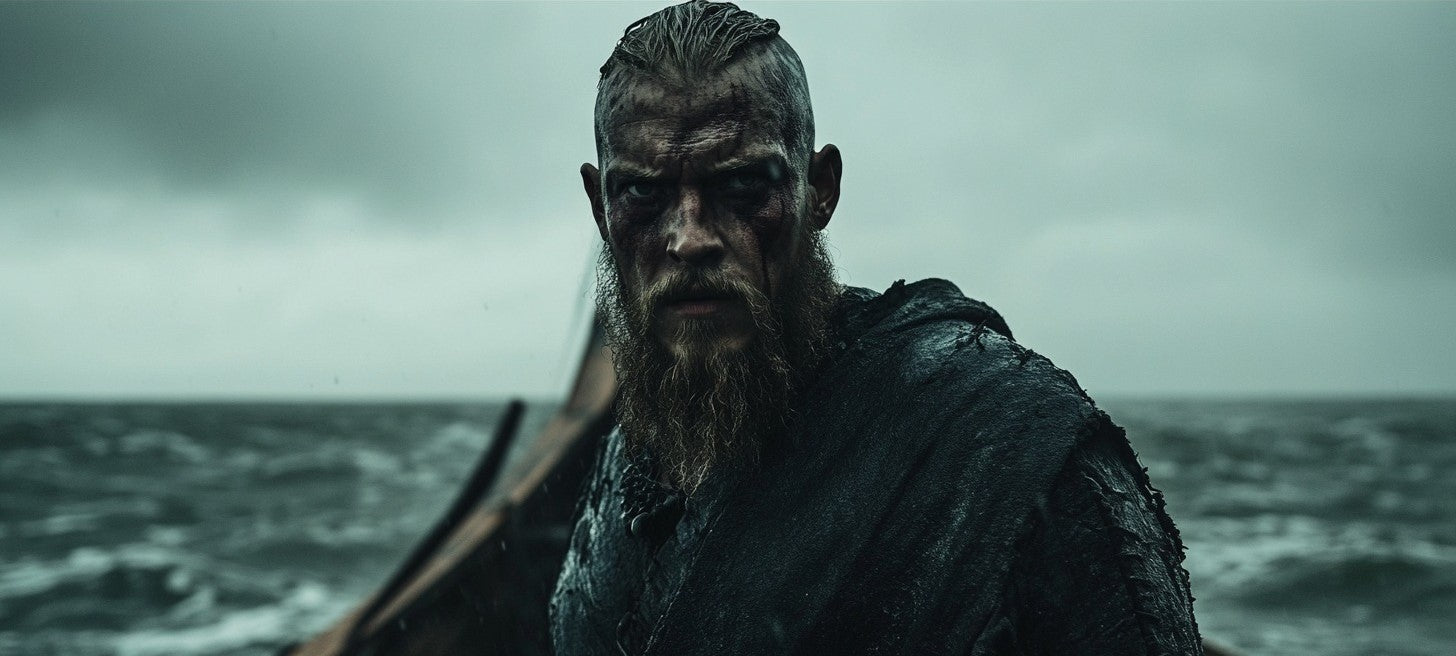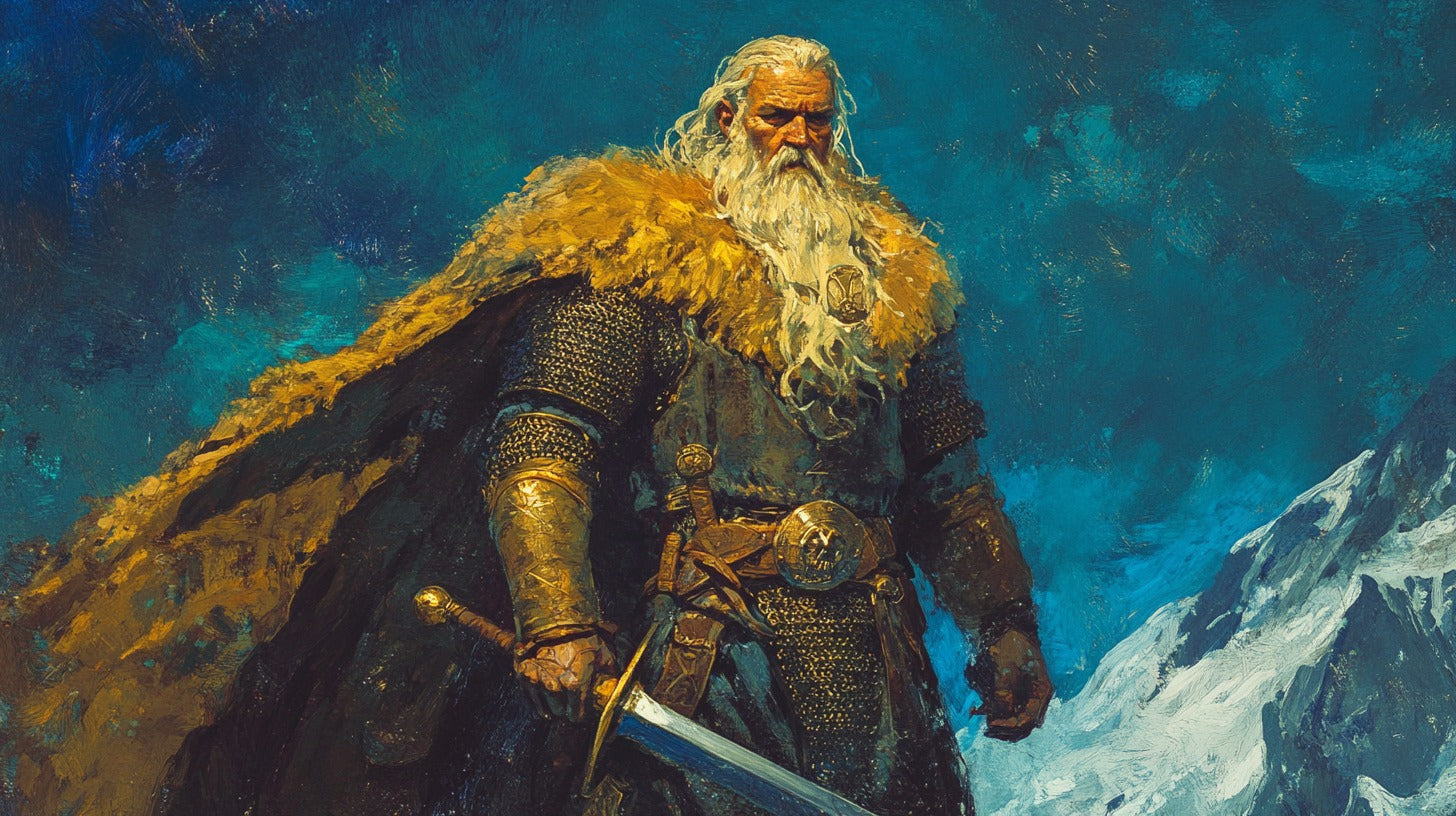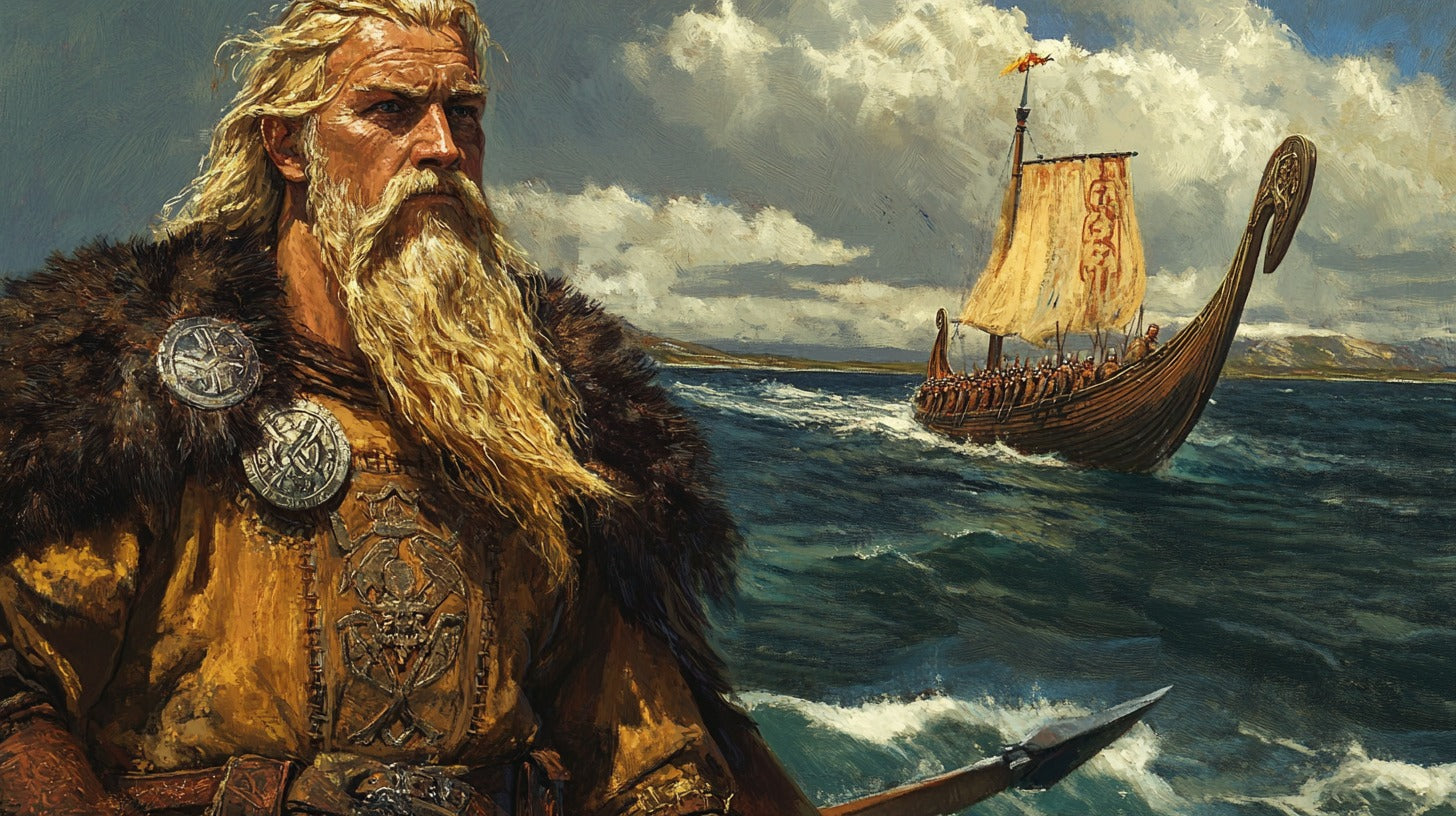
From Sword to Cross: King Olaf II and the Birth of Christian Norway
When the name Olaf Haraldsson echoed through the halls of power in 11th-century Norway, it carried with it the weight of destiny. Little did anyone know that this ambitious prince would not only wear a crown but would one day be venerated as a saint, his legacy shaping the very identity of a nation.
Early Life and Rise to Power
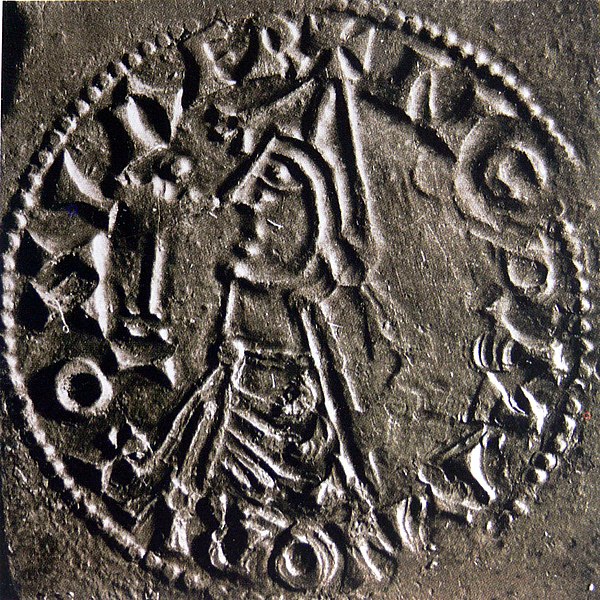
Coin of Olaf II Haraldsson dated 1023–28
Birth and Lineage
In the year 995 during the Viking Age, as the harsh winds of winter howled across the Norwegian landscape, a child was born who would one day wear the crown. Olaf Haraldsson, scion of the legendary Harald Grenske, entered a world of turmoil and strife. The blood of kings flowed through his veins, a legacy that would both bless and curse him throughout his tumultuous life.
From his earliest days, young Olaf was steeped in the lore of his ancestors. Tales of Viking raids and epic battles filled his ears, kindling a fire in his heart that would never be extinguished. The sagas speak of a boy with eyes as fierce as a wolf's and a will as unyielding as the mountains themselves. Little did those around him know that this child would grow to become a force that would reshape the very fabric of Norwegian society.
Exile and Viking Exploits
As Olaf grew into a young man, the political landscape of Norway shifted like ice floes in the spring thaw. Enemies of his family seized power, forcing the young prince into exile. But for Olaf, exile was not a sentence of obscurity, but rather an opportunity for adventure and glory.
He took to the seas, as so many of his forebears had done before him. The salt spray in his face and the rhythmic creaking of oars became his constant companions. Olaf's Viking expeditions carried him to distant shores, from the mist-shrouded coasts of England to the sun-baked ports of Spain. With each raid, each battle, the young warrior honed his skills and built his reputation.
It was during these years of wandering that Olaf first encountered the Christian faith. Like a seed planted in fertile soil, this encounter would grow to become a defining aspect of his life and reign. But for now, the ways of the cross were but a curiosity to the battle-hardened Viking prince.
Olaf's Quest for the Norwegian Throne

Return to Norway
The year 1015 saw Olaf's fortunes change once more. News reached him of political instability in Norway, and the ambitious prince saw his chance. With a fire in his belly and dreams of a crown upon his brow, Olaf set sail for his homeland.
The journey back to Norway was fraught with danger and uncertainty. Olaf navigated not only the treacherous waters of the North Sea but also the even more perilous currents of Norse politics. He gathered supporters like a storm gathering clouds, his charisma and martial prowess drawing both old allies and new to his banner.
Consolidation of Power
Olaf's return to Norway was not met with universal acclaim. The land was divided, with powerful jarls and chieftains each vying for their own piece of the kingdom. But Olaf was not one to be denied his birthright. With sword and diplomacy, he began the arduous task of uniting Norway under his rule.
Battles were fought, alliances forged and broken, and slowly but surely, Olaf's grip on power tightened. He was crowned King of Norway in 1016, but the crown sat uneasily upon his head. Olaf knew that to truly rule, he would need more than just military might. He would need to change the very soul of Norway itself.
The Christianization of Norway
St. Olaf with his ax on a bishop's crozier, made of walrus ivory, Norway c. 1375–1400 / Photo: Aiwok, CC BY-SA 3.0
Olaf's Religious Conversion
The transformation of Olaf from Viking warrior to Christian king was not a sudden one. It was a journey that began in his years of exile and came to fruition as he ascended to the throne. Olaf saw in Christianity not just a personal faith, but a tool to unify his fractious kingdom.
The old gods of Norway, with their tales of valor and vengeance, had long held sway over the hearts of the people. But Olaf envisioned a new Norway, one bound together by a single faith. His conversion was both a personal revelation and a calculated political move, a decision that would echo through the centuries.
Spreading the Faith

Missionary Work
With the zeal of a convert and the determination of a king, Olaf set about the monumental task of Christianizing Norway. He brought priests and missionaries from England and Germany, men of God who would spread the word of Christ to the farthest reaches of his realm.
Churches were built upon the ruins of pagan temples, their spires reaching towards the heavens like fingers of stone. The cross began to appear alongside, and often in place of, Thor's hammer. Olaf himself took an active role in this spiritual conquest, traveling throughout his kingdom to preach and persuade.
Resistance and Conflict
But the old ways did not die easily. Many Norwegians clung to their ancestral beliefs, seeing Olaf's new faith as a threat to their very way of life. Resistance to Christianization was fierce and often bloody. Olaf's methods of conversion were not always gentle; the sagas speak of forced baptisms and the destruction of pagan idols.
This religious strife added yet another layer of complexity to Olaf's reign. He found himself not only fighting external enemies but also battling against the very traditions that had shaped his people for generations. It was a conflict that would define his rule and ultimately lead to his downfall.
Military Campaigns and Territorial Expansion

Battles in Sweden and Denmark
Even as he sought to transform Norway spiritually, Olaf never forgot the arts of war that had brought him to power. His reign was marked by constant military campaigns, as he sought to expand his kingdom and secure his borders.
Sweden and Denmark felt the weight of Olaf's ambitions. Battles raged across Scandinavia, with Olaf's forces clashing against rival kings and jarls. The king himself led from the front, his sword Bæsingr becoming the stuff of legend. Victory followed victory, and for a time, it seemed as though Olaf's dream of a united Scandinavia might become a reality.
The Battle of Stiklestad
But the tides of fortune are ever-changing, and Olaf's luck was about to run out. In 1028, he was forced into exile once more, driven from his throne by an alliance of his enemies. For two years, he bided his time, gathering strength and allies for one final, fateful push to reclaim his crown.
In 1030, Olaf returned to Norway with an army. At Stiklestad, he faced a coalition of Norwegian nobles and Danish forces in a battle that would decide the fate of the kingdom. The clash was brutal and chaotic, a maelstrom of blood and steel beneath a summer sky.
It was here, amidst the fury of battle, that Olaf Haraldsson fell. Struck down by his own people, the warrior king died with his sword in hand. But death was not to be the end of Olaf's story. In many ways, it was only the beginning.
Legacy and Sainthood
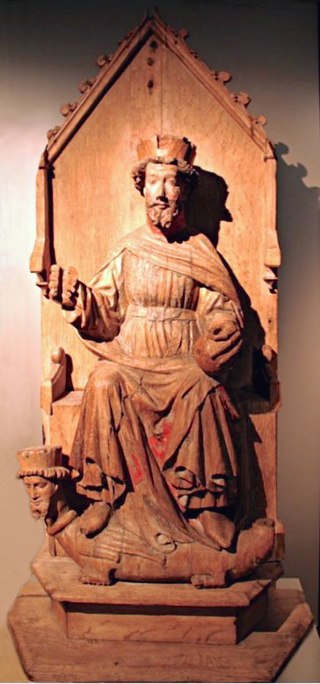
Statue of St. Olav from Austevoll Church, Norway / Photo: Nina Aldin Thune, CC BY-SA 2.5
Posthumous Canonization
In the years following Olaf's death, something remarkable began to happen. Stories of miracles attributed to the fallen king began to spread throughout Norway. The man who had been a controversial figure in life was quickly becoming revered in death.
In 1031, barely a year after his fall at Stiklestad, Olaf was canonized as a saint by Bishop Grimkell. The speed of this canonization was unprecedented and spoke to the profound impact Olaf had made on his people. The warrior king had become St. Olaf, patron saint of Norway.
Influence on Norwegian Culture
St. Olaf's influence on Norwegian culture cannot be overstated. He became a symbol of Norwegian identity and independence, his legacy intertwined with the very idea of Norway itself. Churches were dedicated to him, his image appeared on coins and seals, and his saga was told and retold countless times.
The Christianization that Olaf had begun in life was completed after his death. Norway embraced the new faith with a fervor that would have pleased the fallen king. The old gods faded into memory, replaced by the God that Olaf had championed.
Conclusion
King Olaf II of Norway, St. Olaf, was a man who lived and died by the sword, yet found immortality through faith. His life was a epic tale of ambition, conflict, and transformation, not just for himself but for an entire nation. From Viking raider to Christian king, from controversial ruler to revered saint, Olaf's journey embodies the tumultuous history of medieval Norway.
Today, nearly a thousand years after his death, Olaf's legacy continues to shape Norwegian identity. He stands as a testament to the power of faith, the weight of a crown, and the enduring impact one life can have on the course of history. In the figure of Olaf, we see reflected the struggles and triumphs of a nation coming into its own, forging an identity that would stand the test of time.
The saga of King Olaf II is more than just a story of one man's life. It is the story of Norway itself, a tale of fire and ice, of old gods and new, of a people finding their place in a changing world. And like all great sagas, it continues to inspire and captivate, echoing through the ages like the battle cry of a long-dead king.
FAQs
- Why is King Olaf II also known as St. Olaf?
King Olaf II was canonized as a saint in 1031, shortly after his death, due to reports of miracles attributed to him. He became the patron saint of Norway, hence the name St. Olaf.
- What was King Olaf II's role in the Christianization of Norway?
King Olaf II played a crucial role in spreading Christianity throughout Norway. He brought missionaries from England and Germany, built churches, and sometimes used force to convert his subjects to the new faith.
- How did King Olaf II die?
King Olaf II died in the Battle of Stiklestad in 1030, fighting against a coalition of Norwegian nobles and Danish forces who opposed his rule.
- What is the significance of the Battle of Stiklestad in Norwegian history?
The Battle of Stiklestad is a pivotal event in Norwegian history. While Olaf was killed in this battle, his death and subsequent sainthood accelerated the Christianization of Norway and contributed to the formation of a unified Norwegian identity.
- How is King Olaf II remembered in modern Norway?
King Olaf II is remembered as a national hero and symbol of Norwegian independence and identity. He is commemorated in numerous churches, artwork, and cultural references throughout Norway. His feast day, July 29, is still celebrated as Olsok (St. Olaf's Day) in Norway.
References
Bagge, S. (2014). Cross and Scepter: The Rise of the Scandinavian Kingdoms from the Vikings to the Reformation. Princeton University Press.
Winroth, A. (2012). The Conversion of Scandinavia: Vikings, Merchants, and Missionaries in the Remaking of Northern Europe. Yale University Press.
Lindow, J. (2008). St Olaf and the Skalds. In T. DuBois (Ed.), Sanctity in the North: Saints, Lives, and Cults in Medieval Scandinavia (pp. 103-127). University of Toronto Press.
Sawyer, B., & Sawyer, P. (1993). Medieval Scandinavia: From Conversion to Reformation, circa 800-1500. University of Minnesota Press.
Larson, L. M. (1925). The Earliest Norwegian Laws: Being the Gulathing Law and the Frostathing Law. Columbia University Press.
